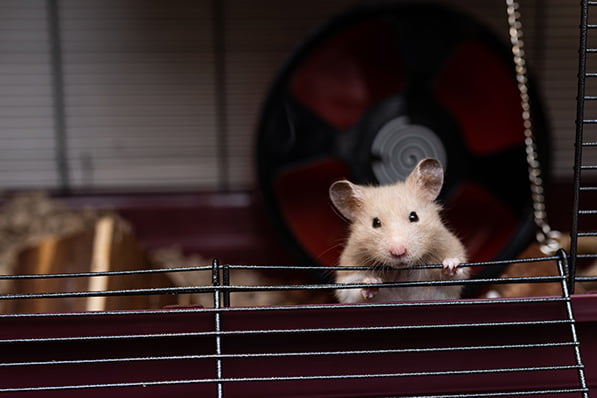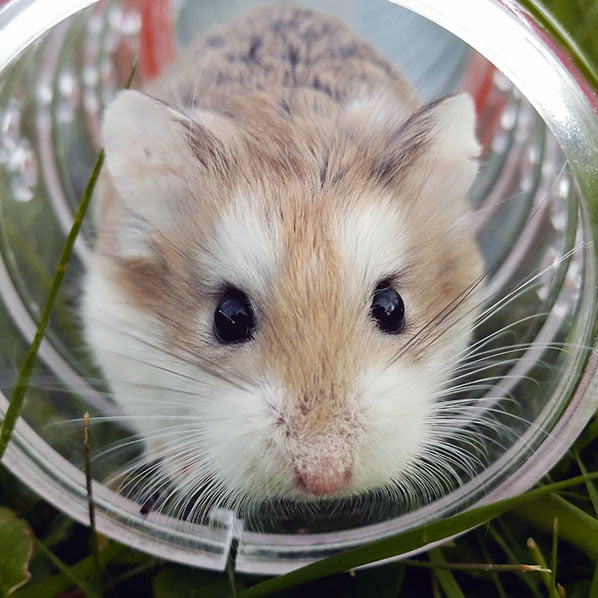The Ultimate Teddy Bear Hamster Care Guide
The Teddy bear hamster is also known as a long-haired Syrian hamster. Teddy bear hamsters got their name due to their similarity to a teddy bear, and they are a popular pet hamster choice for families and kids looking to get started with an easy and lovable small pet. These hamsters are easy to train, easy to care for, and fun to play with.
Whether you are a first-time pet owner or new to teddy bear hamsters, you may wonder do they make a good pet? Are teddy bear hamsters friendly? Do they bite? To help you determine if the teddy bear hamster is right for you, we have put together this care guide in the hope these teddy bear hamster facts can help determine if they are the right pet for you.
Name And Origin of Teddy Bear Hamsters
Teddy bear hamsters are a variation of the Syrian hamster. These Syrian variations are dependent on the hamster's coat type and color. Black bear hamsters, the fancy bear hamster, golden hamster, and teddy bear hamsters are all Syrian hamsters. For example, a fancy hamster has short hair, black bear hamsters have black hair, and a teddy bear hamster's coat consists of long hair, but they are all technically Syrian hamsters.
Syrian hamsters originated in Syria and were first put in captivity in the 1930s. Teddy bear hamsters get their specific name from their cuddly appearance. Their long, usually brown or golden hair, makes them look like a stuffed teddy bears, and their easy, affable natures make them great for children.

Source: Unsplash
Size and Appearance
Teddy bear hamsters are not of the largest hamster breeds available for pet owners, and this breed grows to 4-7 inches, making it almost twice as big as some dwarf hamster breeds. They come in many color and pattern variations, but they all have long fur.
Life Expectancy
Most teddy bear hamsters live to be 2-3 years, and they have one of the longer life expectancies out of all the hamster species. Many are reasonably expected to live even longer, even as long as five years, if they don't suffer from any major health issues.
Housing
The cage you get for your teddy bear hamster will need to be large enough for a 5-7 inch hamster to have space to run around and deep enough for at least 6" of burrowing. You will need to ensure that the cage your get is for Syrian-sized hamsters and not dwarf hamsters.
The best bedding for a teddy bear hamster is shredded paper or aspen shaving. There should be at least six inches deep, so your hamster has lots of space to burrow and dig.
You should provide ample toys including chew toys for your teddy bear hamster to play with and wear its teeth down on. Tunnels, tubes, bridges, hideouts, and DIY playgrounds can be a fun way to entertain your hamster and help it get sufficient exercise. You could also provide a hammock as long as it is low to the ground to prevent harmful falls. An 8-12 inch wheel is another excellent addition to your teddy bear's cage since they love running and will spend hours getting exercise from it.
Your teddy bear hamster's cage should be spot cleaned every day and deep cleaned once a week, removing all soiled bedding, removing hidden food stashes, and wiping down the base of the cage.
Behavior & Temperament
Teddy bear hamsters are one of the easiest pets for first-time owners. They are sweet-natured, easy-going, and can be taught how to enjoy being handled. They are technically nocturnal creatures but often end up with a more crepuscular schedule, being most active at dawn or dusk. This means they sleep during the work or school day and are ready to play in the evening.
A solitary teddy bear hamster is more likely to form a closer bond with its owner, and in general, most hamsters should be kept as solitary animals, given that they can be aggressive toward other hamsters.
Teddy bear hamsters bite only when they feel scared, threatened, or stressed. They have poor eyesight, so it is important to move slowly and calmly to avoid frightening them. You should also never wake them if they are sleeping.
They can be very cuddly, affectionate pets with sufficient training and attachment. With plenty of mental and physical stimulation to keep them busy and a safe, generally quiet environment, teddy bear hamsters are sweet-natured and playful pets.

Source: Unsplash
Feeding
Teddy bear hamsters are omnivores, requiring a diverse range of foods to maintain optimal health. It would be best if you got a quality hamster pellet mix as a base for your hamster's dietary needs. The blend should contain seeds, nuts, and grains, but not a lot of sugary or brightly dyed foods.
Hamsters enjoy insects and other sources of protein like eggs as well. Grains and cereals can be offered, like muesli.
As a pet parent, you are attempting to feed your hamster snacks. However, many snacks at the pet store are packed in sugar and low in nutritional value. To provide healthy snacks to your hamster, you can give them some healthy and fresh vegetables instead. You can provide fresh veggies in small amounts, but you should keep fruit to a minimum to avoid weight gain.
Water
Given the small size, it can be challenging to sex your hamster without veterinary assistance. A male teddy bear hamster tends to be bigger with a more elongated backside, and a female teddy bear hamster tends to be a little smaller with a more rounded backside.
Male testicles may be more prominent, and females will have six pairs of nipples, but these can be hard to locate and identify given the teddy bear hamster's long fur. Consult with a vet if it is important for you to know or if you plan to house more than one together.
Reproduction
Teddy bear hamsters reach sexual maturity at six weeks old and shouldn't be bred until about six months old. Female hamsters will not mate with male hamsters until she is in heat. And teddy bear hamsters are not social animals, so they shouldn't be kept in the same enclosure for more than a few hours. Forcing adult hamsters to live together can cause stress and likely make them very unhappy.
The gestation period of a Teddy hamster is about 16 days but can last up to 21 days. A female hamster can give birth to 20 hamster pups in one litter.
Common Health and Behavior Problems
Health issues in teddy bear hamsters are difficult to catch early since they are often active at night, and it can be hard to know what normal behaviors are and are not. As such, any hamster owner needs to become familiar with the appearance and habits of a healthy hamster so they can more quickly catch signs of illness early on. Since illness can quickly become fatal in a small animal like a hamster, it is even more vital to know what to look for.
Wet Tail Disease
Wet tail disease, or proliferative ileitis, is a condition particularly common in long-coated hamsters.
It is a bacterial infection of the intestines that includes symptoms like lack of appetite, lethargy, liquid or bloody diarrhea, dull coat and eyes, irritability, dehydration, and most notably, a red, raw, sore-infested butt. If not caught and treated early, a wet tail can result in death within 48 hours.
Diabetes
As in humans, diabetes results from the body's inability to create insulin and regulate blood sugar, resulting in high blood sugar and a dangerous strain on the kidneys and other internal organs.
Symptoms of diabetes include excessive thirst, trembling, rapid heartbeat, lethargy, trouble breathing, increased aggression, and even a coma.
Salmonellosis
Salmonellosis is a disease that comes as a result of your hamster eating salmonella-contaminated food. This intestinal disease is indicated by rapid weight loss, vomiting, diarrhea, and eventual death.
Salmonellosis has to be caught early to treat successfully, and if it has progressed too far, euthanizing may be the only humane choice left. This disease is transmittable to humans. So always wash your hands thoroughly if you suspect salmonellosis.
Bladder Stones
Bladder stones are indicated by dark urine, increased urination, bloody urine, UTI, lack of appetite, lethargy, and thirst. Surgery may be required to remove stones, and antibiotics may be used to care for infections.
Cancer
Teddy bear hamsters are susceptible to a number of cancers, particularly the older they get. Females are more at risk than males with cancers of the reproductive organs, thyroid, and adrenal glands.
Cancer symptoms include hair loss, lumps, and a change in behavior. External tumors may be removable, but internal tumors and glandular tumors are often inoperable, and euthanizing may be the only humane option to prevent suffering.
Fancy Bear Hamsters Vs. Teddy Bear Hamsters
Both hamsters have a lot of similarities as they are both Syrian hamsters that are kept as pets. The most significant difference between the two is their coat. A teddy bear hamster has long-haired and a fancy hamster as short hair.
